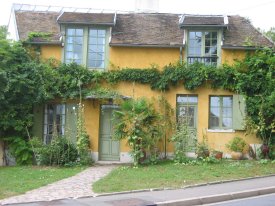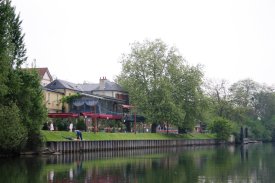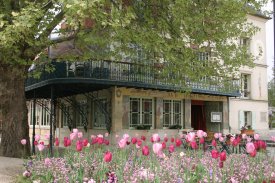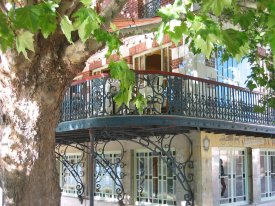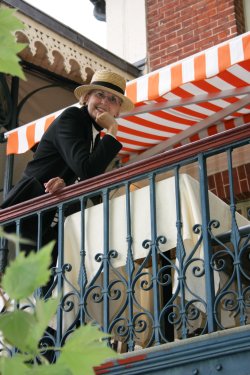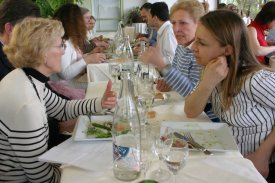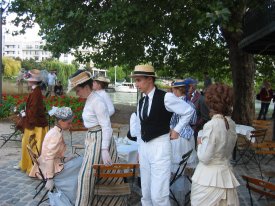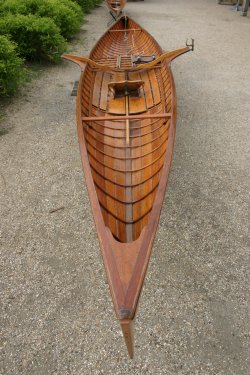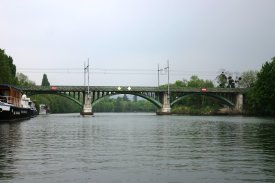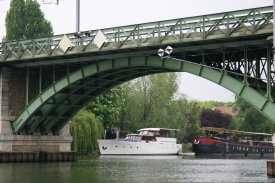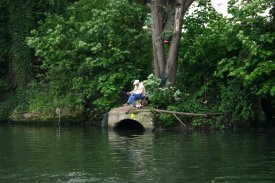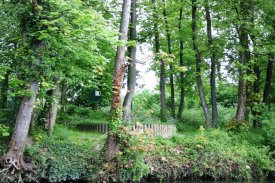Maison Fournaise and the Seine |
|
|
|
Renoir's mother's house in Louveciennes. After retiring from tailoring and dressmaking in Paris, Renoir's parents moved to Louveciennes to a quiet, rural life. Judging from paintings by Sisley (Aqueduct of Marly, 1874) said to have been painted across the street from Renoir's mother's house, and by Pissarro (Rue de village, Louveciennes, 1871), this house on the corner of rue des Voisins and avenue St. Martin was Renoir's parents. It would have been from this house that Renoir set out for Chatou on his steam-cycle in Chapter One, looking for a painting motif as he headed toward Maison Fournaise. |
|
Maison Fournaise. In 1857, Alphonse Fournaise, a river toll collector, established a boat building and rental business on the island of Chatou facing Rueil-Malmaison to the east, and his wife established a restaurant. The great urge of Parisians for diversion in the country newly and easily accessible by rail made a success of both businesses, and they quickly expanded. In the 1870's and 80's, most of the major Impressionists came to the Maison Fournaise and painted nearby, including Claude Monet, Edouard Manet, Alfred Sisley, Camille Pissarro, Gustave Caillebotte, Gustave Courbet, Pierre Prins, and of course Auguste Renoir. Berthe Morisot had a summer house nearby in Bougival. Later, the Fauvists André Derain (born in Chatou), Maurice de Vlaminck, and Henri Matisse discovered the Maison Fournaise. Writers and intellectuals of the day, Guillaume Apollinaire, for example, visited often. Guy de Maupassant rented an upper room from time to time to conveniently serve his passion for rowing. He used the Maison Fournaise as a setting in "La femme de Paul" and "Mouche," calling it Restaurant Grillon. Edgar Degas was also an avid rower who frequented the Maison and knew the family. |
|
Maison Fournaise. Maurice Réalier-Dumas painted the narrow exterior frescoes depicting the Four Ages of Man, as well as comical interior murals. Today, attached to the restaurant and housed in the original boathouse is the Musée Fournaise, a museum dedicated to the work done by all painters of this stretch of the Seine, Impressionists and Fauvists alike, as well as contemporary painters who have captured the spirit of the Seine as it was in prior years. There is a gorgeous film of the river, its painters, and its paintings which plays at the museum continually. The Fournaise Museum www.musee-fournaise.com/fournaise/us/index.asp |
|
Ironwork on Maison Fournaise. In Chapter Four, Alphonsine rows past "the Joly iron foundry that made parts of railroad bridges and their own decorative half-arches that held up the terrace of Maison Fournaise. Alexander, the Russian engineer, had asked her to go with him and her father to see the first one being made here. His excited eyes had looked at her for approval as much as at her father. And now Auguste was going to paint on that terrace. Strange how a dead man was part of the painting." |
|
Alphonsine kept the Maison Fournaise open until 1906. She lived until 1939, after which the building was used as a roominghouse and later left derelict. In 1977 it was purchased by the city of Chatou, and in 1982 it was added to the Register of Historical Monuments. In 1990, it reopened as a restaurant, reinstalling an orange striped awning as in Renoir's painting. |
|
Eating on the terrace Here, prior to going on a boat ride, I'm eating with Madame Anne Galloyer, Curator of the Museum Fournaise (black-and-white stripes) and Madame Noëlle Desplat of l'Association Sequana (blue-and-white stripes, see below). My appetizer, which the French call the entrée because it's the entrance to the meal, was Terrine de lapin au Mère Fournaise, a rabbit pâté prepared the way Louise Fournaise did, in an earthenware crock, served with artichokes, tomatoes and sweet pickles. We just finished our champagne apéritifs, called Alphonsines.
For reservations, |
|
La Journée de la Patrimoine Every third Sunday in September, the holiday of France's national heritage is celebrated at La Maison Fournaise with people in 19th century costume enjoying the music of the period when Renoir painted here. In the open courtyard to the side of the Maison, people of Chatou and surrounding towns keep alive the dances of the gavotte, polka, redowa, mazurka, the grandfather, and, of course, the waltz. |
|
This is the type of one-person racing scull built by Alphonse Fournaise and his son. The périssoires were smaller, narrower boats without oarlocks for one or two paddlers using double bladed paddles. The as was an even narrower craft for one person using double bladed paddles much like a canoe or kayak, and was the most difficult to maneuver. The yole was a recreational boat a meter wide and seven meters long with oarlocks in which the rower faces a cane-backed bench wide enough for the lady to spread out her skirt. She holds steering cords which operate a rudder. The boats were made of overlapping slats of Honduras mahoghany, 3 to 5 millimeters thick. Today, l'Association Sequana, named after the ancient goddess of the river, called Sequana in Roman times, has its boatyard next to the Maison Fournaise on Ile de Chatou, now called Ile des Impressionists. The organization is involved with restoring 19th century boats of all types, even a steam launch, and building those it can no longer find. They have rebuilt the beautiful Roastbeef, designed by Gustave Caillebotte. The friendly and dedicated organization offers promenades sur l'eau, river cruises along the banks where the Impressionists painted, and participates in all river activities in order to keep the patrimony of canotage, recreational boating, alive. To find how to reserve a spot on the one-hour cruises on board the Dénicheur, GOOGLE "sequana association" Find the "Sequana Page d'accueil" and use the Google "Translate this page" feature. Look for the "Tourist Animations" link on the left panel and click it. |
|
Chatou Railroad Bridge This bridge, a quarter mile downstream from Maison Fournaise, is visible in the background of Luncheon of the Boating Party. It's fitting that it's in the painting because it was the means by which Parisians came to the river communities, so for Renoir and other painters of the Seine it was the symbol of the new leisure. In painting it, Renoir is recorded to have said, "The joyous branches of the trees do not hide the railroad bridge which provides a motif for the Impressionists to render homage to modernity." |
|
Chatou Bridge with barge. Alexander Demouy repaired this bridge which was blown up by the French during the Franco Prussian War in 1870 in order to prevent the Prussians from entering Paris by rail. The trees to the left of the far span are saule pleureur, weeping willow, and marronnier d'inde, a flowering chestnut, both very common along the river |
|
Today people fish the Seine more for relaxation than for food, and a fisherman frozen in concentration is a sight for painters and poets. |
|
Once the site of a lively guinguette, La Grenouillère offered day-trippers boats to rent, a swimming area with rental of swimming costumes, a floating restaurant, music, a dance barge, and a tiny island for socializing variously called Le Camembert, looking like a wheel of cheese, or the Flower Pot. Since the 19th century, silt has collected and surrounded the little island that was immortalized by both Renoir and Monet as they painted it side by side in the summer of 1869, discovering together the magic of portraying moving water with distinct brushstrokes of contrasting color, thus giving rise, on this very spot, to the birth of Impressionism. |
